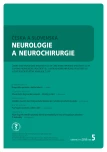Acute Hyperkinetic Syndromes Treated with Stereotactic Neurosurgery Intervention – Three Case Reports
Authors:
A. Fečíková 1; R. Jech 1; J. Roth 1; M. Bareš 2; O. Černá 3; Z. Libá 4; D. Kemlink 1; J. Fiksa 1; A. Křepelová 5; D. Urgošík 1,6
Authors‘ workplace:
Neurologická klinika a Centrum klinických neurověd, 1. LF UK a VFN v Praze
1; 1. neurologická klinika LF MU a FN u sv. Anny v Brně
2; Klinika dětského a dorostového lékařství 1. LF UK a VFN v Praze
3; Klinika dětské neurologie 2. LF UK a FN v Motole, Praha
4; Ústav biologie a lékařské genetiky, 2. LF UK a FN v Motole, Praha
5; Stereotaktická a radiační neurochirurgie, Nemocnice Na Homolce, Praha
6
Published in:
Cesk Slov Neurol N 2015; 78/111(5): 591-596
Category:
Case Report
doi:
https://doi.org/10.14735/amcsnn2015591
Overview
Dyskinetic movement disorders may rarely progress to an acute life-threatening condition requiring admission to an intensive care unit, deep sedation and mechanical ventilation. Stereotactic neurosurgery (pallidotomy or deep brain stimulation) should be considered in all patients who did not respond to pharmacological treatment. We report three patients who underwent stereotactic neurosurgery due to acute dyskinetic syndrome. Two boys (12 and 6 years) with generalized hereditary dystonia (DYT-6 and DYT-1) developed status dystonicus and were treated with deep brain stimulation of the globus pallidus interna. The third patient was a 21-years-old woman with Huntington’s disease who underwent a pallidotomy due to acute worsening of generalized chorea with ballistic movements. Despite the initial critical state of all three patients, their abnormal movements significantly subsided within six weeks after the neurosurgery. The stereotactic neurosurgical procedure should be considered as the method of choice in patients with acute life-threatening hyperkinetic movement disorders that failed to improve with pharmacological treatment.
Key words:
deep brain stimulation – globus pallidus – pallidotomy – hyperkinetic syndromes – status dystonicus – chorea – ballism
The authors declare they have no potential conflicts of interest concerning drugs, products, or services used in the study.
The Editorial Board declares that the manuscript met the ICMJE “uniform requirements” for biomedical papers.
Sources
1. Jankovic J, Penn AS. Severe dystonia and myoglobinuria. Neurology 1982; 32(10): 1195– 1197.
2. Allen NM, Lin JP, Lynch T, King MD. Status dystonicus: a practice guide. Dev Med Child Neurol 2014; 56(2): 105– 112. doi: 10.1111/ dmcn.12339.
3. Fasano A, Ricciardi L, Bentivoglio AR, Canavese C, Zorzi G,Petrovic I et al. Status dystonicus: predictors of outcome and progression patterns of underlying disease. Mov Disord 2012; 27(6): 783– 788. doi: 10.1002/ mds.24981.
4. Manji H, Howard RS, Miller DH, Hirsch NP, Carr L, Bhatia Ket al. Status dystonicus: the syndrome and its management. Brain 1998; 121(2): 243– 252.
5. Teive HA, Munhoz RP, Souza MM, Antoniuk SA, Santos ML, Teixeira MJ et al. Status Dystonicus: study of five cases. Arq Neuropsiquiatr 2005; 63(1): 26– 29.
6. Franzini A, Cordella R, Rizzi M, Marras CE, Messina G, Zorzi G et al. Deep brain stimulation in critical care conditions. J Neural Transm 2014; 121(4): 391– 398.
7. Kumar R, Dagher A, Hutchison WD, Lang AE, Lozano AM. Globus pallidus deep brain stimulation for generalized dystonia: clinical and PET investigation. Neurology 1999; 53(4): 871– 874.
8. Frank S. Treatment of Huntington‘s disease. Neurotherapeutics 2014; 11(1): 153– 160. doi: 10.1007/ s13311‑ 013‑ 0244‑ z.
9. Biolsi B, Cif L, Fertit HE, Robles SG, Coubes P. Long‑term follow‑up of Huntington disease treated by bilateral deep brain stimulation of the internal globus pallidus. J Neurosurg 2008; 109(1): 130– 132. doi: 10.3171/ JNS/ 2008/ 109/ 7/ 0130.
10. Slavin KV, Baumann TK, Burchiel KJ. Treatment of hemiballismus with stereotactic pallidotomy. Case report and review of the literature. Neurosurg Focus 2004; 17(1): E7.
11. Jech R, Bareš M, Křepelová A, Urgošík D, Havránková P,Růžička E. DYT 6 – a novel THAP1 mutation with excellent effect on pallidal DBS. Mov Disord 2011; 26(5): 924– 925. doi: 10.1002/ mds.23599.
12. Coubes P, Vayssiere N, El Fertit H, Hemm S, Cif L, Kienlen J et al. Deep brain stimulation for dystonia. Surgical technique. Stereotact Funct Neurosurg 2002; 78(3– 4): 183– 191.
Labels
Paediatric neurology Neurosurgery NeurologyArticle was published in
Czech and Slovak Neurology and Neurosurgery

2015 Issue 5
- Metamizole vs. Tramadol in Postoperative Analgesia
- Memantine in Dementia Therapy – Current Findings and Possible Future Applications
- Memantine Eases Daily Life for Patients and Caregivers
- Metamizole at a Glance and in Practice – Effective Non-Opioid Analgesic for All Ages
- Advances in the Treatment of Myasthenia Gravis on the Horizon
Most read in this issue
- Diagnostic in Patient with Acute Vertigo
- Recurrent Transient Global Amnesia – Four Case Reports
- Normative Data for the Rey‑ Osterrieth Complex Figure Test in Older Czech Adults
- Contribution of Olfactory Tests to Diagnosis of Neurodegenerative Diseases
